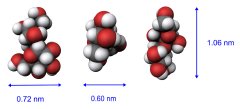Mar 26 2009
In a paper published in the Journal of Nanoparticle Research (Volume 10, number 5, May 2008), scientists working at Malvern Instruments presented experimental protocols for measuring hydrodynamic particle diameters of less than 1 nm, with a precision of 0.1 nm.

The work was carried out using a Malvern Zetasizer particle characterization system, which uses dynamic light scattering (DLS) for particle size measurement. Its optical configuration, comprising a highly sensitive detector in combination with an optimised fibre optic configuration, was a critical factor in the exceptional sensitivity achieved.
The results, which took sucrose as the model material, clearly demonstrate that very precise, verifiable sub-nanometre measurements are now possible. The paper ‘Measuring sub nanometre sizes using dynamic light scattering’, Kaszuba, M. et al., is currently available online with open access, and there is a related application note that can be freely downloaded from the Malvern website.
Particle size is a crucial measure of quality in many applications, and scientific advances have generated a requirement to control increasingly small particles, and molecules. In drug development, for example, proteins are often used as active pharmaceutical ingredients and there is a growing need for techniques sensitive enough to characterise particles in the nanometre size range. Sucrose was chosen as an extreme example, to give confidence in the capability of the system and technology at the limits of the specification.
DLS analyzes time-dependent fluctuations in the intensity of scattered laser light to measure the diffusion coefficient and size of particles. This study research shows that, with careful sample preparation and an appropriate optical configuration, the Zetasizer Nano S accurately measures particle sizes at the sub nanometre scale. These results are highly significant for current and future applications requiring quality control of small molecules.